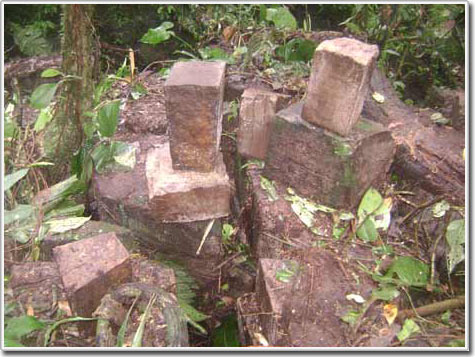Peru's 'legendary city' is actually a natural building
Recent stone structures found in Peru and thought to be an ancient ' lost city ' are in fact a natural building, not built by Inca workers. This information was provided by archaeologists and the Peruvian Ministry of Culture, making the estimate of a local official wanting to turn this place into a tourist destination.
On January 10, the Peruvian national media reported a newly discovered stone castle in a forest east of the Andes. They quoted the local mayor as saying that this structure was discovered by the villagers under the thick trees and named Manco Pata.
Guillermo Torres, mayor of the neighboring Kimbiri region, said that the complex could be the city of Paititi, recorded in local mythology as a stronghold built by the Inca hero Inkarri after his invasion. Spain.
Weeks after the initial report of the discovery, experts from the Peruvian National Institute of Cultural Studies (INC) surveyed the site and finally published their findings on February 12.
In the 4-page report, the researchers concluded that: 'Natural chemicals and physical processes, including stratigraphic activity, created rocks in the area and made them looks like artificial walls or backgrounds. There is no evidence that buildings or archaeological buildings have human participation. '

'Unrealistic'
The report also shows that geological analysis determines the structure of the project is sandstone.'The stones don't show signs of human hand intervention, such as cutting stones.' Scientists also found no trace of mortar at the corners or edges of the rock. 'In addition, there is no evidence that this area has ever been used as a place to gather and manipulate stones.'
The team notes that similar natural structures also appear in Machu Picchu and found no foundations for the walls.
In January, scientists interviewed by National Geographic News were skeptical about the authenticity of the ancient city of Paititi, claiming that historical details noted the location of this legendary city in one another place in the Amazon River. However, based on photos of Manco Pata, some people are still optimistic about the possibility that this place may be an important relic of Inca culture or even Inca culture.
Gregory Deyermenjian, a psychologist and commander of the expedition investigating the legendary Patiti city, said: 'The claims of an extended area are probably too accurate to be impractical.'
Tourism prospects?
Several days after Mayor Torres announced his discovery to the press, he met with experts from the INC, where Manco Pata announced that it was recognized as a national heritage.
When scientists came to this area to investigate its origins, rumors suggested that Torres owned a local travel company and that villagers were aware of the presence of Manco Pata in many year.
Alex Lizaraso, Torres's assistant confirmed in an interview that some people knew about the place but remained silent. He said Torres owned a small company that provided entertainment venues and a pool for students in another town, but he did not expect Manco Pata to bring a great benefit from tourism for the company.'My personal opinion is that everyone exaggerated that the mayor is interested in Manco Pata for personal gain.'
Torres' office did not comment on the new INC report.

The stone works of the Andes, Peru once thought to be the ruins of the ancient city of Paititi are in fact a natural building.(Photo: National Geographic)
- New hypothesis: The legendary city of Atlantis lurks in the heart of the Sahara desert
- The legendary city rises from the deep grave
- Revealing the legendary underwater city of Egypt
- Spot the legendary city of Atlantis
- Find the legendary city of civilization that has mysteriously disappeared?
- 'Find the legendary city of Atlantis'
- Mysterious legends about the legendary city of Atlantis
- Afraid of earthquakes, Japan wants to build a reserve capital
- Highway legendary ancient city under 800m Antarctic ice?
- China built the world's tallest building in 3 months
- 10 legendary ancient legends to this day
- The mystery of famous cities thought to be forgotten but suddenly appeared
 Discovered an ancient centipede fossil 99 million years old
Discovered an ancient centipede fossil 99 million years old Discovered bat-like dinosaurs in China
Discovered bat-like dinosaurs in China Discovered a 200-year-old bronze cannon of the coast
Discovered a 200-year-old bronze cannon of the coast Discover 305 million-year-old spider fossils
Discover 305 million-year-old spider fossils